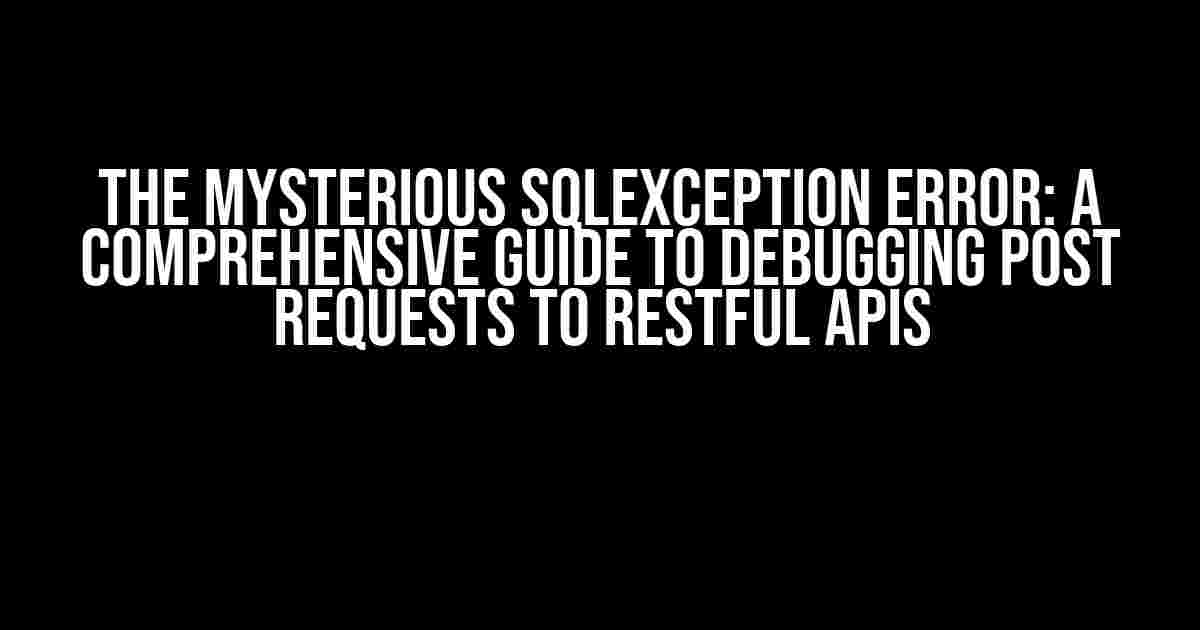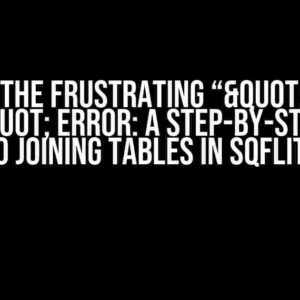Are you tired of pulling your hair out trying to figure out why your beautifully crafted RESTful API suddenly throws a SqlException error after a POST request? You’re not alone! In this article, we’ll delve into the world of database connectivity and explore the most common causes and solutions to this frustrating issue.
What is a SqlException Error?
A SqlException error is a type of exception that occurs when there’s a problem with the database connection or query execution. It can be triggered by a variety of factors, including syntax errors, connection timeouts, or even database schema changes. When a SqlException error occurs, it can bring your entire application to a grinding halt, leaving your users frustrated and your developers stumped.
The Anatomy of a POST Request to a Restful API
Before we dive into the world of SqlException errors, let’s take a step back and examine the typical workflow of a POST request to a RESTful API:
- The client (usually a web application or mobile app) sends a POST request to the API endpoint.
- The API receives the request and processes the input data.
- The API interacts with the database to store or update data.
- The API returns a response to the client, indicating success or failure.
In an ideal world, this process would work seamlessly. However, when a SqlException error occurs, it can happen at any point during this workflow, making it challenging to diagnose and resolve.
Common Causes of SqlException Errors After POST Requests
Now that we’ve set the stage, let’s explore the most common causes of SqlException errors after POST requests to RESTful APIs:
- Database Connection Issues: Firewalls, network connectivity problems, or incorrect database credentials can all lead to SqlException errors.
- Syntax Errors in SQL Queries: Typos, incorrect syntax, or outdated database schema can cause SqlException errors.
- Database Schema Changes: Changes to the database schema, such as adding or removing columns, can break the API’s database interactions.
- Concurrency Issues: When multiple requests are processed simultaneously, it can lead to concurrency issues, resulting in SqlException errors.
- Resource Constraints: Insufficient database resources, such as memory or CPU, can cause SqlException errors.
- ORM Misconfiguration: Incorrect configuration of Object-Relational Mappers (ORMs) like Entity Framework or Hibernate can lead to SqlException errors.
Debugging Techniques for SqlException Errors
Now that we’ve identified the common causes, let’s explore some essential debugging techniques to help you resolve SqlException errors:
Enable SQL Profiling
SQL profiling tools, such as SQL Server Profiler or Oracle SQL Developer, can help you capture and analyze the SQL queries being executed by your API. This can reveal syntax errors, incorrect database credentials, or other issues.
// Enable SQL profiling in .NET Core
services.AddDbContext(options =>
{
options.EnableSensitiveDataLogging(true);
options.EnableDetailedErrors(true);
});
Log SQL Queries and Exceptions
Logging SQL queries and exceptions can provide valuable insights into what’s happening under the hood. You can use logging frameworks like Serilog or NLog to capture and log SQL queries and exceptions.
// Log SQL queries and exceptions using Serilog
logger.LogInformation("Executing SQL query: {@SqlQuery}", sqlQuery);
logger.LogError(ex, "SqlException error: {ErrorMessage}", ex.Message);
Verify Database Connection and Credentials
Double-check your database connection string, credentials, and firewall settings to ensure they’re correct and up-to-date.
// Verify database connection string and credentials
string connectionString = "Server=myserver;Database=mydatabase;User Id=myuser;Password=mypassword;";
using (var connection = new SqlConnection(connectionString))
{
connection.Open();
// ...
}
Review Database Schema and Indexes
Verify that your database schema and indexes are up-to-date and correctly configured. Missing or incorrect indexes can lead to performance issues and SqlException errors.
// Review database schema and indexes
using (var context = new MyDbContext())
{
context.Database.ExecuteSqlCommand("EXEC sp_helpindex 'MyTable'");
// ...
}
Use ORM Debugging Tools
If you’re using an ORM like Entity Framework or Hibernate, utilize their built-in debugging tools to analyze and resolve issues.
// Enable Entity Framework debugging
DbContext.Database.Log = (sql => Debug.WriteLine(sql));
Best Practices for Avoiding SqlException Errors
To minimize the risk of SqlException errors, follow these best practices:
- Use parameterized queries: Parameterized queries can help prevent SQL injection attacks and reduce the risk of syntax errors.
- Implement error handling: Catch and handle exceptions gracefully to prevent application crashes and provide a better user experience.
- Regularly update database schema: Stay up-to-date with the latest database schema changes to avoid compatibility issues.
- Monitor database performance: Keep an eye on database performance metrics to identify potential bottlenecks and issues.
- Test thoroughly: Perform comprehensive testing, including load testing and stress testing, to ensure your API can handle high traffic and concurrency.
Conclusion
SqlException errors after POST requests to RESTful APIs can be frustrating and challenging to resolve. However, by understanding the common causes, using effective debugging techniques, and following best practices, you can minimize the risk of these errors and ensure a seamless user experience. Remember to stay vigilant, monitor your database performance, and continually improve your API’s resilience to avoid those pesky SqlException errors.
| Cause | Solution |
|---|---|
| Database Connection Issues | Verify database connection string and credentials, check firewall settings |
| Syntax Errors in SQL Queries | Use parameterized queries, enable SQL profiling, log SQL queries and exceptions |
| Database Schema Changes | Regularly update database schema, review database schema and indexes |
| Concurrency Issues | Implement error handling, use transactions, optimize database performance |
| Resource Constraints | Monitor database performance, optimize database resources, scale database |
| ORM Misconfiguration | Verify ORM configuration, use ORM debugging tools, update ORM version |
By following these guidelines and staying proactive, you’ll be well-equipped to tackle even the most stubborn SqlException errors and ensure a smooth, reliable, and scalable RESTful API.
Frequently Asked Question
Are you tired of encountering SqlException errors after sending a POST request to your RESTful API? Don’t worry, you’re not alone! Here are some frequently asked questions and answers to help you troubleshoot and resolve this pesky issue:
What causes a SqlException error after a POST request to a RESTful API?
A SqlException error can occur due to various reasons, including incorrect database connection strings, invalid SQL queries, database permission issues, or even missing database tables or columns. Yep, it’s a long list, but don’t worry, we’ll get to the bottom of it!
How do I debug a SqlException error in my RESTful API?
To debug a SqlException error, enable error logging in your API, inspect the error message, and check the inner exception for more details. You can also use tools like SQL Server Management Studio or Entity Framework’s SQL logging feature to trace the SQL queries executed by your API.
What’s the difference between a SqlException and a DbException?
While both exceptions are related to database errors, a SqlException is specifically thrown by the .NET Framework’s SQL Client when a SQL query fails, whereas a DbException is a more general exception type that can be thrown by various database providers, including Entity Framework.
Can I catch a SqlException error in my RESTful API’s controller method?
Yes, you can catch a SqlException error in your controller method using a try-catch block. However, it’s essential to handle the exception properly, log the error, and return a meaningful error response to the client.
How can I prevent SqlException errors in my RESTful API?
To prevent SqlException errors, ensure that your database connection string is correct, validate user input, use parameterized SQL queries, and implement robust error handling mechanisms. Regularly testing your API and monitoring database performance can also help identify potential issues before they become errors.




